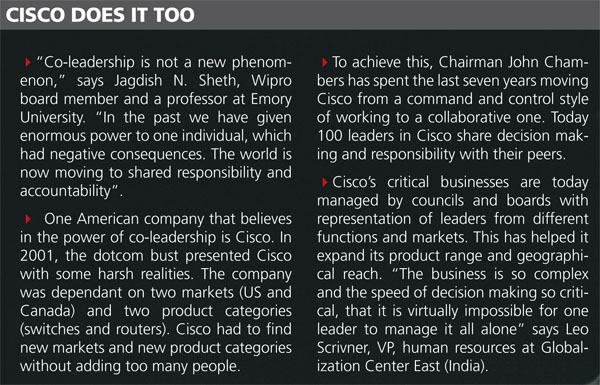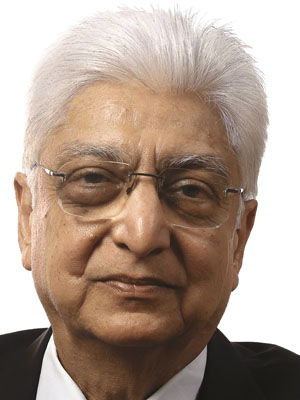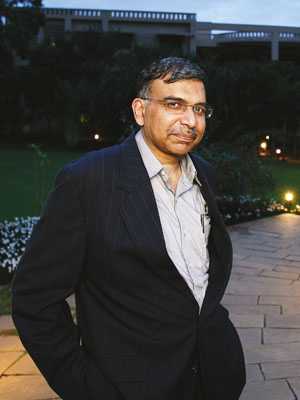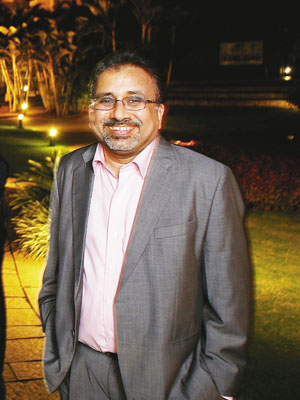
Azim Premji's Double Bet
Two leaders running one business is an idea that has very few backers. Azim Hashim Premji is one of them
Inside Wipro’s headquarters at Sarjapur in Bangalore, they have a nickname for Suresh Vaswani: Josh. The moniker refers to his hard charging, aggressive personality and an exceptional selling prowess. At the company’s campus at Electronic City not far away, sits Girish Paranjpe. Insiders call him Hosh, largely for his even temper and an ability to think long-term. On a sunny day in March two years ago, Azim Premji, Wipro’s founder-chairman, decided to bring the two very different personalities to lead the same business — the $4.2 billion information technology business that accounted for 90 per cent of Wipro’s profits. When colleagues heard about Premji’s move to install Vaswani and Paranjpe as co-CEOs, they were aghast. It seemed to have all the makings of a rare misadventure by a man known to think unconventionally.
A mix of historical compulsions and serendipity may have pushed Premji to try out the tandem leadership model at his company, but the experience since then may have given him the confidence to replicate it in his other ventures. Says Premji, “In many ways, the opportunity here (at APF) was no different - we have a huge mandate, large canvas, two very accomplished leaders who have worked together and [the] benefit of the Wipro experience. So why not use it here too?” Today, APF is reaching an inflexion point. Set up with $125 million donation from Premji, the foundation works at improving the quality of primary education across 20,000 government schools in nine states. This month, it received the permission to set up the first private university in Karnataka.
But when Premji first tried the joint CEO structure at Wipro, many were convinced it would fail in a few months. Many theories floated around — that Premji was forced to compromise because he could not find one capable leader; that he was worried that if he made one of them the CEO, the other would leave; or that he was creating internal competition to divide and conquer. The fact that Rishad Premji, his son, had joined the company in 2007 made matters even more complicated.
Azim Premji told his team to “ignore the sceptics and get on with the task ahead.”
And the sceptics appear to have got it wrong. “If it (the co-CEO structure) was a compromise then our performance would have also got compromised,” says Pratik Kumar, human resources head. Instead, Wipro posted a strong performance over the two years. Last year, Wipro’s IT revenues have grown by 30 percent and profits by 28 percent. Wipro’s valuation of $33 billion is higher than even Accenture today. Premji’s belief that two is better than one stands vindicated.
The Genesis
Succession planning had been on Premji’s mind ever since Vivek Paul, the man who helped him to build Wipro into a multi-billion dollar enterprise, left in 2005 to become a venture capitalist. Premji carved Wipro’s IT business into separate business units and appointed a president for each unit. But he had to provide overall leadership which meant that a lot of his time was sucked out for operational issues leaving him little time for futuristic planning. Pushing 60 and with no clear successor in sight, Premji had quite a task in hand. He needed a CEO but was reluctant to hire from outside. After all, Wipro is known for a strong home-grown culture that an outsider may not immediately fit into.
As Premji looked for solutions, the idea of joint leadership began to take shape. One of the first to broach the subject was board member Ashok S. Ganguly, who had rich experience working in such an environment at Unilever. (Ganguly didn’t confirm that it was his idea, only saying that it was the board’s unanimous decision to appoint co-CEOs). His point was that the IT business had become a lot bigger and more complex since Paul left, making it difficult for one person to lead it.
Premji considered the idea carefully and eventually decided it merited a look by the board. The directors, on their part, deliberated for six months before agreeing to it. “We thought through a lot of apprehensions. We debated a lot and identified the areas where we expected conflict,” says Suresh Senapaty, chief financial officer and board member. What finally clinched the decision was that “both of them had worked in Wipro for a long time. We may not have done the same if it were an outsider,” says Senapaty.
In March 2008, Premji was visiting his company’s campus in Electronic City to meet an important client. After the meeting, he walked into Girish Paranjpe’s office to talk to him about an important matter. Paranjpe was at that time heading the unit serving banking, financial services and insurance companies, a business worth $1 billion in revenues. Premji asked Paranjpe if he was ready to run the company’s flagship IT business along with Suresh Vaswani, who was then head of Wipro’s India and Middle East IT business.
The suddenness of the discussion caught Paranjpe by surprise. He was aware that Premji had been mulling over a co-CEO structure for some time. But he wasn’t expecting the decision to reach his doorstep so soon. Paranjpe felt both anxious and happy. Premji left him to talk to Suresh Vaswani with the same offer.
The Wipro boss made his expectations clear to both. Vaswani and Paranjpe must work on each other’s strengths. They would have distinct responsibilities but they would also be jointly accountable for the business performance. To their team members, they would have to present the ‘one leader-one face’ image.
On April 18, 2008, the board announced that the duo would take over as joint CEOs of Wipro’s IT business.
How They Made it Work
Paranjpe and Vaswani had a chat a day before the announcement. They agreed on some rules. One, they would not break the business into two parts but share the load. Second, they would discuss every large decision between themselves before taking it to others. Initially, they would appear jointly before the press and talk in one voice. They would keep their mutual dissent private.
Premji gave them the responsibilities their respective personalities deserved. Vaswani got charge of sales, while Paranjpe earned the chief technology officer’s office, consulting practice and large accounts. The main business lines were divided between them with Vaswani heading manufacturing, retail, energy and utilities and Paranjpe in charge of financial services, technology and telecom.
Then Premji sewed up their fate together by putting Paranjpe in charge of overall delivery and Vaswani in charge of global sales. Both of them had joint responsibility of core functions like strategy, HR and finance as well as financial performance.
True to their word, both Vaswani and Paranjpe have tried to keep their differences away from the eyes of their teams. “Whatever be their differences, we don’t see them settling it in front of us,” says a senior member of the Wipro leadership team. Once a month, both the leaders do a joint review of the business with the entire 31 top team members. They also keep each other in the loop on important matters over an informal lunch meeting every week. Slowly they built trust and gained each other’s confidence. So much so that Paranjpe says that they have now relaxed to express occasional disagreement in front of their reporting managers.
And everyone’s worst fear that Premji would have to spend his whole time settling their disputes didn’t come true. “Even the board thought that there would be a lot of arbitration by the chairman, but it was hardly required,” says Vaswani. “Too much was made of our personality differences.”
Culture Matters
Premji could try out a co-leadership model at Wipro perhaps because he owns 80 percent of it. Such a plan in a widely held company would have been much more difficult to pull off. However, insiders say that it was not a question of ownership alone. Wipro’s culture and Premji’s management style were key factors. “In Wipro, we work a lot more collaboratively. There is no super hero system here,” says Behar.
Behar cites the example of Wipro’s latest diversification, the eco energy business. “It didn’t happen because it was Premji’s idea. I had the idea and talked to five people in Wipro, all friends of mine... Then it went to AHP [Premji] and he said it will never work. We kept fighting. Just because Premji didn’t like it at first, it didn’t mean I would give up. It went on and on and the more the dialogue continued, he started getting into it. He started doing his own research and spoke to several experts around the world and after each trip would come and tell us what he found. It took six to nine months for the idea to finally form and it developed only because of this collaborative dissent style of working,” says Behar.
Premji knows every small detail of his businesses, but does not interfere with everyday operations of the various independent business heads. But what he does is to talk to a cross section of employees. Unless specifically asked for an intervention, Premji also prefers to leave his managers to find their own solutions to problems.
T.K. Kurien, the new boss at Wipro Eco Energy, refers to Premji’s style of “management by walking”. “The way Premji will tell you what’s on his mind is by asking you to come for a walk around the campus,” he says. Premji is often seen walking around his Sarjapur campus with some business leader or the other. During these walks, Premji hints what’s on his mind and also gauges his companion’s perspective on how the businesses are doing.
The model of tandem leadership is all about true empowerment of the staff and a commitment by the dual leaders to work for the greater common good. It is this benign mix that Premji wants to replicate in his foundation. Behar and Ranjekar, who will jointly head APF, are already close to each other. They have worked together for a long time and talk several times a day.
It was always known that Behar would one day take over the Foundation’s work. But the urgency came from the permission for starting a private university. “The mandate is so huge that no one person can do it alone,” says Behar. But although Behar and Ranjekar will have independent areas of operation, they have been careful in letting the team members know that when they start work together, it will not be in silos. “We want this to be a force multiplier, not an efficiency reducer,” says Behar. So the teams have been told that they could go to anyone of them for a decision and that “each of them would be able to speak on each other’s behalf,” adds Behar.
But the organisation’s work is not yet done. Wipro continues to fine-tune its experiment and Premji might well expand it to other activities. One thing that most people wonder is how long this structure will last? Some insiders believe that it will last at least three years or so, but finally it will be down to just one CEO managing the whole business. The company offers no clue to how it is thinking. Senior leaders say management structures are specific to a time and context. Ganguly would only say “organisations are not carved in stone.”
When Wipro organised a two-day workshop on co-leadership for 24 of its top managers, it made sure the training was given by two coaches working together. Chief Learning Officer Abhijit Bhaduri says that “the reason we are choosing two coaches to lead the programme is also deliberate; it gives a real life situation of how two leaders manage a situation.”
(Additional reporting by Neelima Mahajan-Bansal) Read Ajim Premji's interview on next page...
Premji says the co-leadership model worked in his company thanks to the professionalism shown by the two he picked as CEOs

Q: The joint CEO structure in the IT business has been operational for two years now. Has it met your and the board’s expectations in how the CEOs have delivered?
A: This was never an easy structure to start with. In our assessment, it has worked better than what we had anticipated.
Q: We heard that there were concerns at the board level and inside the organisation that you would have to spend a lot of time in arbitration. How often have the two CEOs come to you for arbitration?
A: If the board had any concerns, those were legitimate concerns as one would have with any change, especially with change as significant as this one. The structure has worked because of remarkable maturity shown by the two individuals. There have been very, very few instances where I have had to step in.
Q: Do you have a formal mechanism for resolving any disagreements between the two CEOs? Or is it done more informally?
A: We have very rigorous process of reviews where the Joint CEOs and the functional heads are involved. Unresolved issues, if any are discussed and debated at length in these reviews. The approach is not to impose a view on them, but to guide them to find a solution on their own. However issues do not have to necessarily wait for a formal review for it to surface. [They] can get picked up any time.
Q: Why do you think two CEOs will be good for the Azim Premji Foundation?
A: In many ways, the opportunity here was no different. We have a huge mandate, large canvas, two very accomplished leaders who have worked together and benefit of Wipro experience. So why not use it here too?
Q: What was your personal advice to Vaswani and Paranjpe, and now to Behar and Ranjekar, on how they should handle this?
A: Frankly, not much. These are very fine leaders and know how to put their minds and shoulders together to challenges and opportunities. Possibly, the only thing which I advised them was to ignore the skeptics and get on with the task ahead.
(This story appears in the 02 April, 2010 issue of Forbes India. To visit our Archives, click here.)
-
 Jeevan
JeevanWhat is so tough about it? I have no clue !! <br /> <br /> 1 - One person controls 80% of the company. Imagine the clout. <br /> <br /> 2. If you are good (really good), you can jump easily like Mr. Nandy who joined Aricent. If not, you have stuck it out when you are at the last mile of your career. I am not sure of Mr. Behar's and its result though yet. It is too early. <br /> <br /> 3. It is IT services, not products. In products, it is a different ball game. Imagine 2 CEOs in Microsoft or Apple. Even Google does not have it. Cisco is different case - a company built via acquisition. <br /> <br /> Is the research proper on it? Is the conclusion drawn proper? On what basis the author is saying it is a success (but the title is a bet!)<br /> <br /> Disclosure - I am an ex-wiproite. At Wipro, it is Premji all the way.
on Mar 30, 2010

















